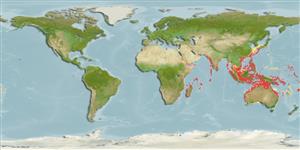Environment: milieu / climate zone / depth range / distribution range
Ecology
Marine; brackish; reef-associated; depth range 10 - 80 m (Ref. 86942), usually 5 - 10 m (Ref. 127519). Tropical
Western Pacific.
Size / Weight / Age
Maturity: Lm ? range ? - ? cm
Max length : 22.0 cm TL male/unsexed; (Ref. 48636)
Dorsal soft rays (total): 39 - 41. Males recognized by long dorsal fin rays and large size (Ref. 48636). Under dorsal fin with 1 or 2 free pterygiophores (Ref 12934).
Found in steep sand slopes in large aggregations (Ref. 8631). Hovers above clean sandy bottoms; darts into the sand when disturbed. Usually slightly silty habitat. Usually seen resting on substrate, leaving substrate to grab prey from zooplankton floating over, or when displaying (Ref. 48636).
Life cycle and mating behavior
Maturity | Reproduction | Spawning | Eggs | Fecundity | Larvae
Randall, J.E., G.R. Allen and R.C. Steene, 1990. Fishes of the Great Barrier Reef and Coral Sea. University of Hawaii Press, Honolulu, Hawaii. 506 p. (Ref. 2334)
IUCN Red List Status (Ref. 130435: Version 2024-1)
Threat to humans
Harmless
Human uses
Fisheries: commercial; aquarium: commercial
Tools
Special reports
Download XML
Internet sources
Estimates based on models
Preferred temperature (Ref.
123201): 24.6 - 29, mean 28 °C (based on 932 cells).
Phylogenetic diversity index (Ref.
82804): PD
50 = 0.5020 [Uniqueness, from 0.5 = low to 2.0 = high].
Bayesian length-weight: a=0.00389 (0.00180 - 0.00842), b=3.12 (2.94 - 3.30), in cm total length, based on all LWR estimates for this body shape (Ref.
93245).
Trophic level (Ref.
69278): 3.4 ±0.45 se; based on food items.
Fishing Vulnerability (Ref.
59153): Low vulnerability (12 of 100).
Nutrients (Ref.
124155): Calcium = 78.6 [42.2, 129.3] mg/100g; Iron = 0.722 [0.444, 1.207] mg/100g; Protein = 18.5 [17.4, 19.5] %; Omega3 = 0.103 [0.060, 0.187] g/100g; Selenium = 37.1 [17.9, 73.1] μg/100g; VitaminA = 125 [45, 367] μg/100g; Zinc = 1.78 [1.21, 2.50] mg/100g (wet weight);
